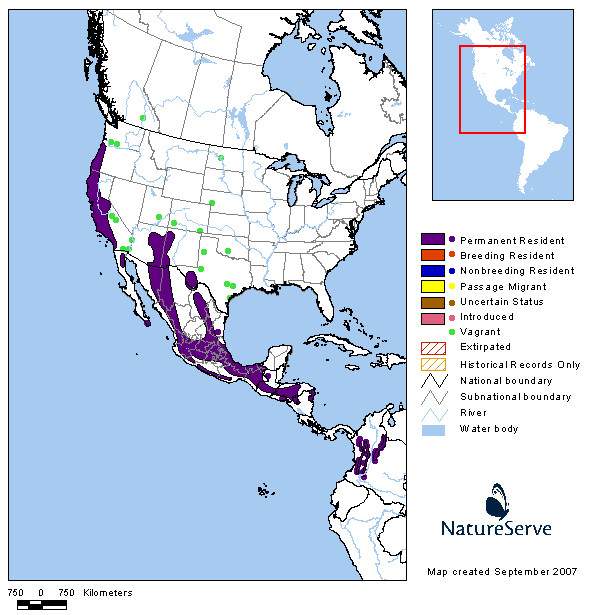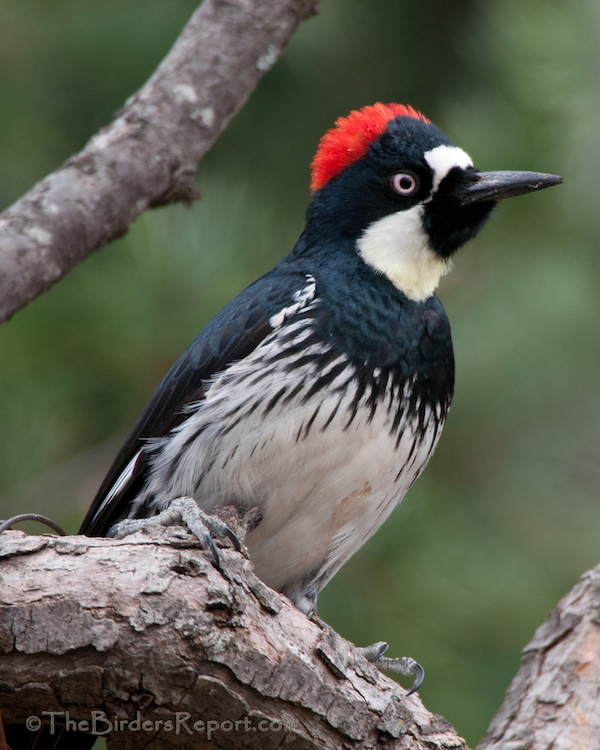Why would I call these beautiful woodpeckers the “clowns of the avian world?” Besides the facial features of the Acorn Woodpecker (Melanerpes formicivorus) appearing somewhat clown-like, they are a joy to watch and some of their antics are sure to bring a smile to anyone’s face.
Both the male and female of the species have a bright red crown. The adult female (below) has a wide black band separating her red crown from the white forehead whereas the adult male has a solid red crown. Click on photos for full sized images.
You can get a brief look into their comical behavior from this video showing two females at my woodpecker feeder. You can hear their calls throughout the video but at the 53 second mark, the second female comes in and gives the typical call with the head bob.
Shortly after the first bird leaves the feeder, the remaining woodpecker peaks around the edge of the feeder. Many woodpeckers show this endearing behavior of peaking around from the back side of tree branches and trunks.
httpv://youtu.be/HUkc0mEnSVU
This is the male Acorn Woodpecker hanging from my suet feeder. Note the pale yellow eyes also seen in the adult female.
These birds inhabit foothill and mountain woodlands and are closely associated with oaks and usually found in pine-oak woodlands. This is their range map courtesy of Nature Serve.

Most Acorn Woodpeckers are cooperative breeders and live in family groups of up to a dozen or more individuals. Within a group, 1–7 male co-breeders compete for matings with 1–3 joint-nesting females who lay their eggs in the same nest cavity. Groups may also contain up to 10 male and female non-breeding helpers, usually offspring of the group produced in prior years1.
The result of this cooperative breeding strategy is that fledging success increases with group size and survivorship is also significantly higher for all birds living in these larger groups1.
This is a photo of a juvenile at my water feature. Both male and female juveniles have full red crowns and the darker blue iris.
Acorn Woodpeckers are the only species to store individual nuts in holes drilled in granaries. An individual granary tree may contain only a few or as many as 50,000 holes, each of which is typically filled with an acorn in the fall. This photo of a granary tree is courtesy of Wikipedia Commons.

Insects are the preferred food of this woodpecker, supplemented by acorns when insects are not available. They can often be seen hawking insects from the tops of trees and gleaning them from the bark.
They can also be seen at woodpecker feeders like the one this male is visiting in my back yard.
Acorn Woodpeckers are obviously very handsome birds and a load of fun to watch. I leave you with this image of a female at the nut feeder with her tongue sticking out. Enjoy!
References: 1Birds of North America Online


















Very nice post with great pictures as usual! Do the acorn granaries only serve as a source of acorns or are they farming insects within the nuts, to be eaten later?
@Jonathan, an excellent question! To quote Birds of North America Online “Stored acorns are often infested with insect larvae, especially those of wasps, moths, and weevils. Such larvae are almost certainly eaten when found. However, there is no truth to the idea that stored acorns are nurseries for insect larvae. Most insect larvae pupate and leave acorns as they dry out, and thus few remain by the time stored acorns are consumed.”
Large granaries are the result of several generations of woodpeckers drilling holes and storing the nuts so they may be stored for several years. Acorn Woodpeckers also eat the nuts right from the tree, usually placing them in a crevice that will hold the nut for them as they crack it open. They also do this with sunflower seeds, unlike many passerines that hold the seed between their feet to crack seeds open.
I always think of them as clowns too! Great images of this beautiful woodpecker.
Great post – a very unique woodpecker! Enjoyed the video very much.
Great post Larry. The Acorn Woodpeckers are mighty handsome. I love how the black patterns on their faces sort of drips down onto the breast. Great information and photos, thanks for sharing.
Thanks for the info! See the PBS Nature program on Woodpeckers!
For what it’s worth, in Mexico these birds are actually called Carpinteros Arlequín (Harlequin, or Clown, Woodpeckers). And it’s interesting to me to read of their “hawking” insects on the wing. The first time I saw them do that, I thought of it as “flycatchering”, but it was definitely the same behavior.
Thanks Chris! I just watched it yesterday, superb show!
Yes Chris, I have seen them hawking insects many times. Amazing clowns they are!